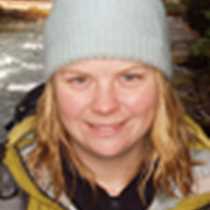Tracy Arm & Williams Cove
We woke this morning in a landscape carved by ice and amidst ice bergs sculptured by water. The sun shone brightly and enveloped us with an unexpected yet welcomed warmth. As we traveled further into the fjord, the steep walls towered above us and the vegetation diminished. Much to our surprise, several mountain goats were traveling on the rocky shore near sea level. This gave us the rare opportunity to see these sure-footed, steep-slope loving animals up close. As the ice thickened, the sightings of Arctic terns increased, some of which had fish in their bills, the breakfast for their chicks.
South Sawyer Glacier, the tidewater glacier parent to all the ice bergs, has retreated rapidly in the past few years leaving a strip of naked rock where it once resided. The plethora of ice calved daily provides a valuable haulout substrate for harbor seals. As we scanned the ice, we saw these small earless seals lounging like sausages on the ice taking in the summer sun. For the first time this trip, we boarded the Zodiacs and navigated our way through the ice-strewn water for a better view of the glacier.
As we cruised away from the glacier, it was as if we were racing through geologic time; small plants replaced bare rocks and eventually we were in a mature Sitka spruce forest in Williams Cove. We donned our rubber boots and stepped foot, for the first time, in the Tongass National Forest, the largest national forest in the United States and one of the few temperate rainforests in the world. Whether we were hiking along the well-worn bear trails through the forest or exploring the cove by kayak, we gained a greater understanding and respect for the wildness around us.
We woke this morning in a landscape carved by ice and amidst ice bergs sculptured by water. The sun shone brightly and enveloped us with an unexpected yet welcomed warmth. As we traveled further into the fjord, the steep walls towered above us and the vegetation diminished. Much to our surprise, several mountain goats were traveling on the rocky shore near sea level. This gave us the rare opportunity to see these sure-footed, steep-slope loving animals up close. As the ice thickened, the sightings of Arctic terns increased, some of which had fish in their bills, the breakfast for their chicks.
South Sawyer Glacier, the tidewater glacier parent to all the ice bergs, has retreated rapidly in the past few years leaving a strip of naked rock where it once resided. The plethora of ice calved daily provides a valuable haulout substrate for harbor seals. As we scanned the ice, we saw these small earless seals lounging like sausages on the ice taking in the summer sun. For the first time this trip, we boarded the Zodiacs and navigated our way through the ice-strewn water for a better view of the glacier.
As we cruised away from the glacier, it was as if we were racing through geologic time; small plants replaced bare rocks and eventually we were in a mature Sitka spruce forest in Williams Cove. We donned our rubber boots and stepped foot, for the first time, in the Tongass National Forest, the largest national forest in the United States and one of the few temperate rainforests in the world. Whether we were hiking along the well-worn bear trails through the forest or exploring the cove by kayak, we gained a greater understanding and respect for the wildness around us.



